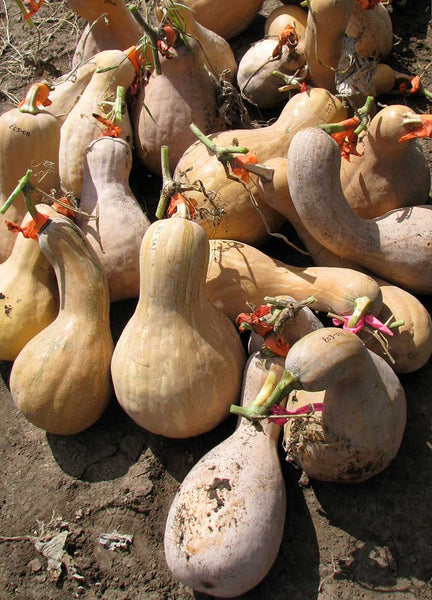
By Liz Fairchild, Retail Assistant
Maybe, like me, you’ve wondered before about distinctions between varieties within the squash family, or cucurbits. For example, all the squash packets in our collection state that one may consume the fruit "when small and immature as summer squash, and mature as winter squash." This led me to think summer squashes are just immature winter squash. I discovered that's not always true. Then there is the rumor of cross-pollination amongst family members. And just how are the different varieties related? So I have gone in search of enlightenment and wish to report to our readers. I will break my report into several blog posts, beginning today with a botanical overview of the Cucurbitaceae, the family of gourds and squashes.
While there are many ways people have described and categorized the plant world, the language of taxonomy is tremendously helpful when understanding relatedness between varieties, especially in a family with so many exciting and diverse members. The Cucurbitaceae are a plant family containing over a hundred member genera, or groups. The singular form of genera is genus, and we often describe crop plants using "binomial nomenclature," which means stating both the genus and species, as in Cucurbita moschata.

Magdalena Big Cheese (header image) and Carrizo Squash (above) are both members of same genus and species, Cucurbita moschata.
Speaking of Cucurbita moschata, here we have a great example of a single species that comprises a number of beloved cultivars, such as butternut squashes (like Corrizo, Mayo Kama) and pumpkins like Magdalena Big Cheese.
In addition to Cucurbita, in our seed bank at Native Seeds/SEARCH are accessions from several more economically important genera from around the globe: Citrullus, Cucumis, Lagenaria, and Luffa. Most gourds, and the varieties in our collection, are in the Lagenaria genus. In the Citrullus group are the refreshing watermelons, and fragrant, juicy melons are within the Cucumis genera. (Cucumbers are also members of this genera, but these have not historically been a major crop in our region and are not part of our collection.) The fifth Cucurbitaceae genera we have in the seedbank are the Luffa – yes, this is the same fruit that is so fibrous when it's mature that it's used to scrub things clean. We have one small, delicate luffa variety, thanks to the Mayo in Mexico.
Plants in the Cucurbitaceae family are fast-growing and either grow prostrate (spreading on the ground), or have tendrils and are climbers; they have palmate leaves on long stalks. Most species have separate male and female flowers on the same plant, and are insect-pollinated out-crossers, preferring pollination via other plants. What we eat as a vegetable is botanically defined as a berry, fleshy and with lots of seeds. As the family was domesticated in the warm tropics, they are frost-tender and love the heat, like our Sonoran summers.
In future posts, I'll go into more detail about varieties within species, which ones will or won't cross, and how we preserve their unique qualities from generation to generation.
